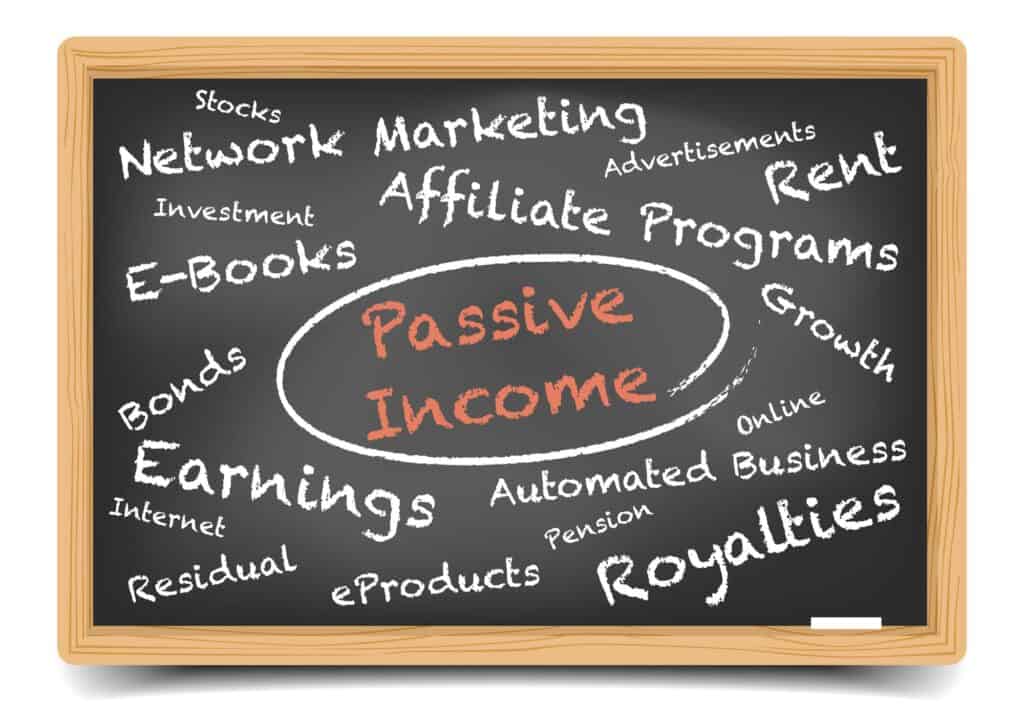Passive income refers to the earnings that are generated with minimal effort or active involvement on the part of the recipient. It is income that continues to be generated even when you are not actively working. This is in contrast to active income, which is earned through direct participation in a job or business. Passive income can come from a variety of sources, such as real estate investments, dividend stocks, peer-to-peer lending, affiliate marketing, online courses, royalties, YouTube monetization, and creating and selling digital products.
Disclaimer: This information is general in nature and for informational purposes only. It is not personal financial advice and has not taken into account your personal financial position or objectives. Make sure to refer to a licensed financial or tax advisor.
There are several benefits to earning passive income. First and foremost, it provides financial stability and security. By diversifying your income streams and having multiple sources of passive income, you are less reliant on a single source of income, such as a job. This can provide a safety net in case one source of income dries up or becomes less profitable.
Passive income also offers the potential for financial freedom and flexibility. With passive income streams in place, you have the ability to earn money while you sleep or while you pursue other interests and passions. This can give you the freedom to spend more time with family and friends, travel, or pursue hobbies without worrying about money.
Diversifying your income streams is important because it spreads out your risk and reduces your dependence on any one source of income. By having multiple passive income streams, you are not putting all your eggs in one basket. If one source of income underperforms or fails, you still have other sources to rely on.
Table of Contents
Real Estate Investments: Rental Properties and REITs
Real estate investments are a popular form of passive income. There are two main ways to invest in real estate: through rental properties or through real estate investment trusts (REITs).
Rental properties involve purchasing a property and renting it out to tenants. The rental income generated from the property becomes your passive income. However, owning and managing rental properties can require a significant amount of time and effort. You need to find tenants, collect rent, handle maintenance and repairs, and deal with any issues that may arise. It is important to carefully consider the responsibilities and potential challenges before investing in rental properties.
REITs, on the other hand, are a more passive way to invest in real estate. REITs are companies that own and manage income-generating real estate properties, such as apartment buildings, office buildings, or shopping centers. By investing in REITs, you can earn a share of the rental income generated by these properties without the need to directly own or manage them. REITs are traded on stock exchanges, making them easily accessible to individual investors.
When considering real estate investments, it is important to weigh the pros and cons. One of the main advantages of real estate investments is the potential for long-term appreciation. Real estate has historically been a reliable investment that tends to increase in value over time. Additionally, rental properties can provide a steady stream of passive income that can be used to cover expenses or reinvested for further growth.
However, there are also risks and challenges associated with real estate investments. The real estate market can be volatile and subject to fluctuations. Property values can go down as well as up, and rental income may not always be consistent. Additionally, owning and managing rental properties requires time, effort, and expertise. It is important to thoroughly research and understand the local real estate market before making any investment decisions.
Dividend Stocks: Investing in Companies with Steady Dividend Payouts
Dividend stocks are another popular form of passive income. Dividends are regular cash payments that companies distribute to their shareholders as a share of their profits. By investing in dividend stocks, you can earn a passive income stream through these regular dividend payments.
Dividend stocks offer several advantages as a passive income stream. First, they provide a steady and predictable source of income. Companies that pay dividends tend to be more established and financially stable, which can provide a sense of security for investors. Dividends can also be reinvested to purchase additional shares of stock, allowing for potential growth over time.
However, there are also risks and considerations to keep in mind when investing in dividend stocks. Dividend payments are not guaranteed and can be reduced or eliminated by the company if it faces financial difficulties. It is important to carefully research and select dividend stocks from companies with a history of consistent dividend payments and strong financial performance.
Additionally, dividend stocks are subject to market fluctuations and can be affected by changes in interest rates, economic conditions, and industry trends. It is important to diversify your dividend stock portfolio to spread out the risk and minimize the impact of any individual stock’s performance.
When investing in dividend stocks, it is important to consider your investment goals, risk tolerance, and time horizon. Dividend stocks can be a good option for long-term investors who are looking for a steady income stream and potential growth over time.
Peer-to-Peer Lending: Earning Interest on Loans to Individuals or Businesses
Peer-to-peer lending is a relatively new form of passive income that has gained popularity in recent years. It involves lending money to individuals or businesses through online platforms that connect borrowers with lenders. As a lender, you earn interest on the loans you make, providing a passive income stream.
One of the main advantages of peer-to-peer lending is the potential for high returns. The interest rates on peer-to-peer loans are often higher than those offered by traditional banks, allowing lenders to earn a higher rate of return on their investments. Additionally, peer-to-peer lending platforms typically offer tools and resources to help lenders assess the creditworthiness of borrowers and manage their investments.
However, there are also risks associated with peer-to-peer lending. The loans made through these platforms are not insured by the government, so there is a risk of default. It is important to carefully evaluate the creditworthiness of borrowers and diversify your lending portfolio to minimize the impact of any individual loan defaulting.
Additionally, peer-to-peer lending platforms may charge fees or have restrictions on withdrawals, which can affect the overall return on investment. It is important to carefully read and understand the terms and conditions of the platform before investing.
When considering peer-to-peer lending as a passive income stream, it is important to do your due diligence and thoroughly research the platforms and borrowers. Look for platforms with a track record of success and positive reviews from lenders. Consider diversifying your lending portfolio by investing in loans with different risk profiles and loan terms.
Affiliate Marketing: Promoting Products or Services for a Commission
Affiliate marketing is a popular form of passive income that involves promoting products or services on behalf of a company or brand. As an affiliate marketer, you earn a commission for each sale or lead that is generated through your promotional efforts.
Affiliate marketing offers several advantages as a passive income stream. First, it requires minimal upfront investment or overhead costs. You do not need to create or manufacture your own products, as you are promoting existing products or services. Additionally, affiliate marketing can be done from anywhere with an internet connection, providing flexibility and freedom.
Another advantage of affiliate marketing is the potential for high earnings. As an affiliate marketer, you can earn a percentage of each sale or a fixed commission for each lead generated through your promotional efforts. The more sales or leads you generate, the more money you can earn.
However, there are also challenges and considerations to keep in mind when engaging in affiliate marketing. The competition in the affiliate marketing space can be fierce, so it is important to choose a niche or target audience that is not oversaturated. Additionally, building an audience and establishing trust and credibility can take time and effort.
When engaging in affiliate marketing, it is important to choose products or services that align with your interests and expertise. This will make it easier for you to create valuable and authentic content that resonates with your audience. It is also important to disclose your affiliate relationships and comply with any legal requirements or guidelines set by the affiliate program or platform you are using.
Online Courses: Creating and Selling Digital Courses on Various Topics
Online courses have become a popular form of passive income for individuals with expertise in a particular subject or skill. Creating and selling digital courses allows you to share your knowledge and expertise with others while earning a passive income.
One of the main advantages of creating and selling online courses is the scalability. Once you have created a course, it can be sold to multiple students without requiring any additional effort on your part. This allows you to reach a larger audience and earn income from your course over an extended period of time.
Additionally, online courses offer flexibility and freedom. You can create and sell courses on a wide range of topics, allowing you to leverage your existing skills and knowledge. You can also create courses at your own pace and schedule, giving you the ability to work on your course when it is convenient for you.
However, there are also challenges and considerations to keep in mind when creating and selling online courses. Creating a high-quality course requires time, effort, and expertise. You need to carefully plan and structure your course content, create engaging videos or materials, and provide ongoing support to your students.
Additionally, marketing and promoting your course can be a challenge. With the increasing popularity of online courses, there is a lot of competition in the market. It is important to develop a marketing strategy to reach your target audience and differentiate your course from others.
When creating and selling online courses, it is important to choose a topic or subject that you are passionate about and have expertise in. This will make it easier for you to create valuable and engaging content that resonates with your students. It is also important to continuously update and improve your course based on student feedback and market trends.
Royalties: Earning Income from Intellectual Property, such as Books or Music
Earning royalties from intellectual property, such as books or music, is another form of passive income. Royalties are payments made to the creator or owner of a copyrighted work for the use or distribution of that work.
One of the main advantages of earning royalties is the potential for long-term passive income. Once you have created a copyrighted work, such as a book or a song, you can earn royalties from its use or distribution for many years to come. This can provide a steady stream of income without requiring ongoing effort or active involvement.
Additionally, earning royalties allows you to leverage your creativity and talent. If you have a passion for writing, music, or other creative pursuits, earning royalties can provide a way to monetize your work and earn income from your artistic endeavors.
However, there are also challenges and considerations to keep in mind when earning royalties. The process of creating and marketing a copyrighted work can be time-consuming and competitive. It requires talent, skill, and dedication to create high-quality work that resonates with an audience.
Additionally, the royalty rates and payment terms can vary depending on the industry and the specific agreements you have in place. It is important to carefully review and negotiate any contracts or agreements to ensure that you are receiving fair compensation for your work.
When earning royalties, it is important to protect your intellectual property rights and ensure that your work is properly copyrighted. This will help prevent others from using or distributing your work without permission and ensure that you receive the appropriate royalties for its use.
YouTube: Monetizing Videos through Advertising and Sponsorships
YouTube has become a popular platform for earning passive income through video content. By creating and monetizing videos on YouTube, you can earn income through advertising and sponsorships.
One of the main advantages of monetizing YouTube videos is the potential for a large audience. YouTube has billions of users worldwide, providing a vast audience for your videos. If you are able to create engaging and valuable content that resonates with your audience, you can attract a large number of views and subscribers.
Additionally, YouTube offers several monetization options. You can earn income through advertising, where ads are displayed before or during your videos. You can also earn income through sponsorships, where companies pay you to promote their products or services in your videos.
However, there are also challenges and considerations to keep in mind when monetizing YouTube videos. Building an audience and attracting views and subscribers can be a competitive process. It requires consistent effort and high-quality content to stand out from the crowd.
Additionally, the income earned from YouTube can vary depending on factors such as the number of views, the engagement of your audience, and the types of ads or sponsorships you are able to secure. It is important to diversify your income streams and not rely solely on YouTube for passive income.
When monetizing YouTube videos, it is important to create content that is valuable and engaging for your target audience. This will help attract views and subscribers and increase the likelihood of earning income through advertising and sponsorships. It is also important to comply with YouTube’s policies and guidelines to ensure that your videos are eligible for monetization.
Creating and Selling Digital Products: E-books, Software, and More
Creating and selling digital products is another form of passive income that has gained popularity in recent years. Digital products include e-books, software, online courses, templates, graphics, and more. By creating and selling digital products, you can earn income from your expertise or creative skills.
One of the main advantages of creating and selling digital products is the scalability. Once you have created a digital product, it can be sold to multiple customers without requiring any additional effort on your part. This allows you to reach a larger audience and earn income from your product over an extended period of time.
Additionally, creating and selling digital products offers flexibility and freedom. You can create products on a wide range of topics or subjects, allowing you to leverage your existing skills and knowledge. You can also create products at your own pace and schedule, giving you the ability to work on your product when it is convenient for you.
However, there are also challenges and considerations to keep in mind when creating and selling digital products. Creating a high-quality digital product requires time, effort, and expertise. You need to carefully plan and structure your product, create engaging content or materials, and provide ongoing support to your customers.
Additionally, marketing and promoting your digital product can be a challenge. With the increasing popularity of digital products, there is a lot of competition in the market. It is important to develop a marketing strategy to reach your target audience and differentiate your product from others.
When creating and selling digital products, it is important to choose a topic or subject that you are passionate about and have expertise in. This will make it easier for you to create valuable and engaging content that resonates with your customers. It is also important to continuously update and improve your product based on customer feedback and market trends.
Choosing the Right Passive Income Stream for You
In conclusion, there are many different passive income streams available, and the right one for you will depend on your individual goals, interests, and resources. It is important to carefully consider factors such as the level of effort required, the potential return on investment, and the long-term sustainability of the income stream. Some people may prefer to invest in real estate and earn rental income, while others may find success in creating and selling digital products or starting a blog. Ultimately, the key is to choose a passive income stream that aligns with your skills, passions, and financial objectives. By doing so, you can create a reliable source of income that allows you to enjoy more freedom and flexibility in your life.
Looking for more ideas on how to generate passive income? Check out this informative article on PassiveIncomeSolutions.org that explores various strategies to build a steady stream of passive income. From investing in real estate to creating an online course, this article covers the top 10 sources of passive income and provides valuable insights on how to get started. Don’t miss out on this opportunity to learn more about maximizing your earning potential. Read more here.
FAQs
What is passive income?
Passive income is money earned without actively working for it. It is generated from investments, rental properties, or other sources that require minimal effort to maintain.
What are the top 10 sources of passive income?
The top 10 sources of passive income include rental properties, dividend-paying stocks, peer-to-peer lending, creating and selling digital products, affiliate marketing, creating an online course, investing in a high-yield savings account, creating a mobile app, investing in a real estate investment trust (REIT), and investing in a dividend ETF.
How much money can you make from passive income?
The amount of money you can make from passive income varies depending on the source and the amount of investment. Some sources may generate a few hundred dollars per month, while others can generate thousands of dollars per month.
Is passive income taxable?
Yes, passive income is taxable. The amount of tax you pay on passive income depends on the source and the amount of income generated.
Do you need a lot of money to start generating passive income?
No, you do not need a lot of money to start generating passive income. Some sources, such as creating and selling digital products or affiliate marketing, can be started with minimal investment.
Is passive income a reliable source of income?
Passive income can be a reliable source of income if you invest in the right sources and maintain them properly. However, it is important to remember that passive income is not guaranteed and can fluctuate depending on market conditions.
Can passive income replace a full-time job?
Passive income has the potential to replace a full-time job, but it depends on the amount of income generated and the individual’s financial needs. It is important to have multiple sources of passive income to ensure financial stability.
What are the benefits of generating passive income?
The benefits of generating passive income include financial freedom, the ability to work less and enjoy more leisure time, and the potential to build wealth over time.
What are the risks of generating passive income?
The risks of generating passive income include market fluctuations, the potential for loss of investment, and the need to maintain and manage the sources of passive income.







